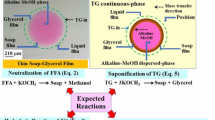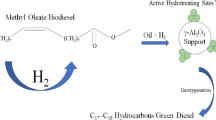Abstract
A metal methoxide is more expensive than a metal hydroxide and dissolves in methanol releasing a methoxide ion without producing water. The methoxide ion has a higher reaction rate making it more preferred for industrial biodiesel production. This study describes the preparation of alkoxide catalysts from metal hydroxides and non-volatile, non-toxic polyols. Heating aqueous solutions of metal hydroxides and different polyols (1,2-propanediol, 1,3-propanediol, glycerol, xylitol and sorbitol) under vacuum yielded polyol-derived alkoxide base catalysts (PDABC). Comparison of the drying process for respective sodium hydroxide-polyol combinations at two mole ratios of sodium hydroxide to polyol showed that drying at 2:1 mole ratio (metal hydroxide to polyol) was more efficient than that of 3:1. Dehydration of alkaline solutions containing three or more hydroxyl groups (glycerol, sorbitol and xylitol) was faster than drying similar solutions of diols. The empirical formula determined confirmed that the resulting powders contained mono-sodium substituted alkoxides at 1:1, 2:1 and 3:1 (sodium hydroxide: polyol) mole ratio. Fatty acid methyl esters were prepared from canola oil and methanol using glycerol sodium alkylate as a catalyst. The conversion yield of oil to methyl ester was greater than 99 %.





Similar content being viewed by others
References
Crabtree RH (2009) The organometallic chemistry of the transition metals. Wiley, Hoboken
Van Leeuwen PWNM (2004) Homogeneous catalysis understanding the art. Kluwer Academic Publishers, Boston (pp. xiii, 407 p.)
Basu HN, Norris ME (1996) Process for production of esters for use as a diesel fuel substitute using a non-alkaline catalyst. US Patent 5,525,126
Liu KS (1994) Preparation of fatty acid methyl esters for gas-chromatographic analysis of lipids in biological materials. J Am Oil Chem Soc 71:1179–1187
Horn M, Horns U (2000) Alkoxides, metal. kirk-othmer encyclopedia of chemical technology. Wiley. DOI: 10.1002/0471238961.0112111508151814.a01
Liebig J (1837) Über die Aethertheorie, in besonderer Rücksicht auf die vorhergehende Abhandlung Zeise's. Ann Pharm 23:12–42
YaT Nataliya (2004) Metal oxoalkoxides. Synthesis, properties and structures. Russ Chem Rev 73:1041–1064
Mehrotra RC (1988) Synthesis and reactions of metal alkoxides. J Non-Cryst Solids 100:1–15
Turova NY (2002) The chemistry of metal alkoxides. Kluwer Academic Publishers, Boston
Reaney MJT, Westcott ND (2007) Methods for preparation and use of strong base catalysts. WO 2007(022621):A2
Reaney JT, Liu YD, Westcott ND (2002) Method for commercial preparation of conjugated linoleic acid. U.S Patent 6,414,171
Budavari S (1996) The Merck index: an encyclopedia of chemicals, drugs, and biologicals, 12th edn. Merck, Whitehouse Station
Rendleman JA (1966) Alkali metal complexes of carbohydrates. I. Interaction of alkali metal salts with carbohydrates in alcoholic media. J Org Chem 31:1839–1845
Cornils B, Weber J, Bernhagen W, Springer H (1983) Process for preparing 2,3-dimethyl-2,3-butanediol. U.S Patent 4,404,410
Rich HW, Hegetschweiler K, Streit HM, Erni I, Schneider W (1991) Mononuclear, oligonuclear and polynuclear iron (III) complexes with polyalcohols formed in alkaline aqueous media. Inorg Chim Acta 187:9–15
Wade LG (1999) Organic chemistry, 4th edn. Prentice-Hall, Upper Saddle River
Kelsey DR (1994) Purification of 1,3-propanediol. U.S Patent 5,527,973
Budavari S (1989) The Merck index: an encyclopedia of chemicals, drugs, and biologicals, 11th edn. Merck, Rahway
Gross FC, Jacobs JM (1926) A new method for the preparation of alkali glyceroxides. J Soc Chem Ind Lond 45:320T–321T
Author information
Authors and Affiliations
Corresponding authors
About this article
Cite this article
Gok, H.Y.F., Shen, J., Emami, S. et al. Polyol-Derived Alkoxide/Hydroxide Base Catalysts I. Production. J Am Oil Chem Soc 90, 291–298 (2013). https://doi.org/10.1007/s11746-012-2157-0
Received:
Revised:
Accepted:
Published:
Issue Date:
DOI: https://doi.org/10.1007/s11746-012-2157-0




